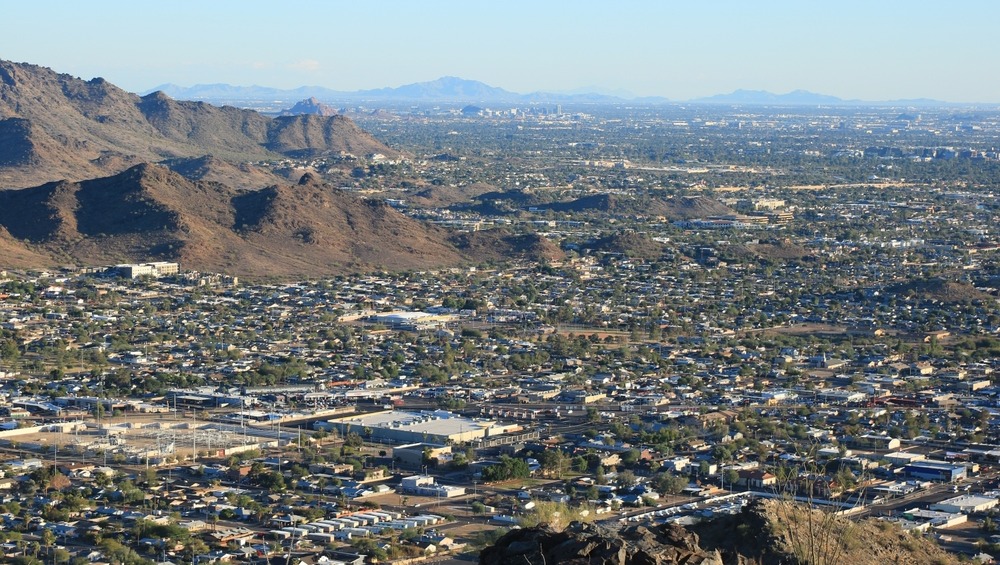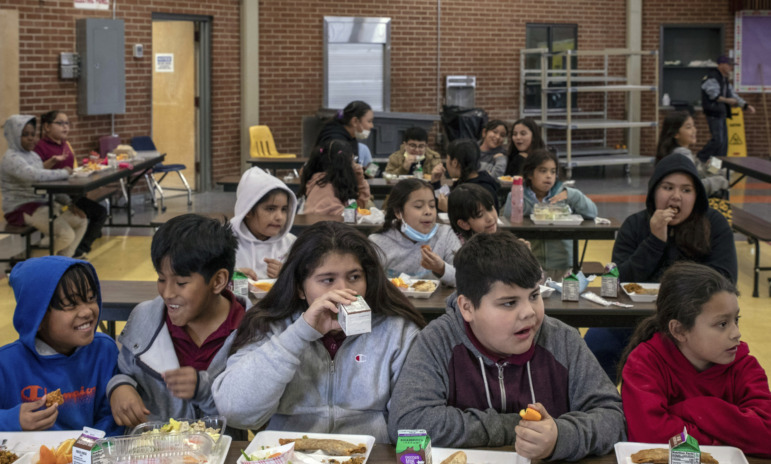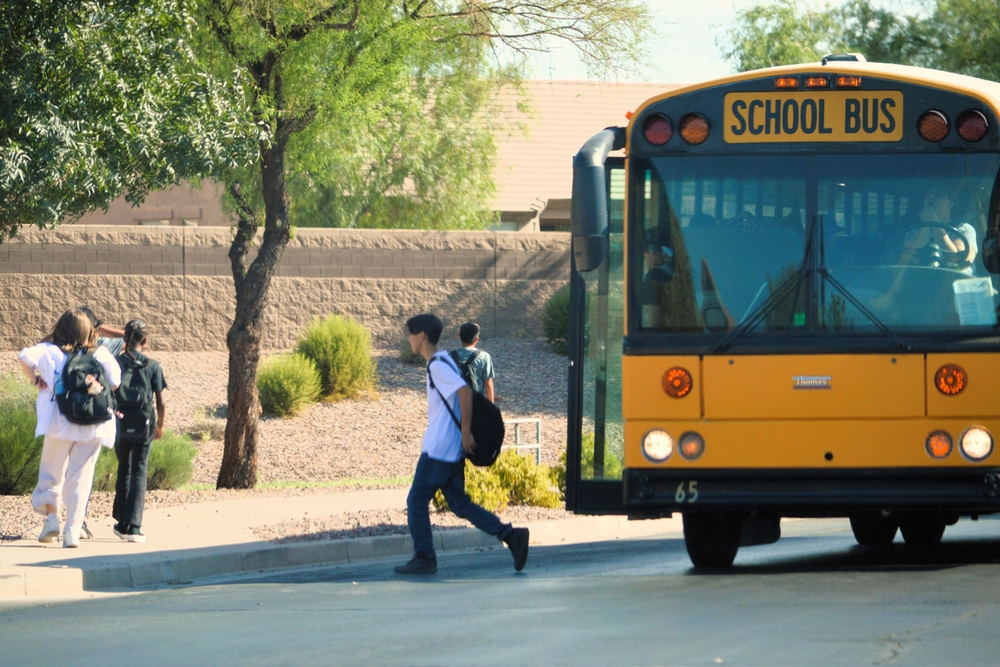This story was originally published by ProPublica.
 Reporting Highlights
Reporting Highlights
- Not a Choice for Everyone: In Arizona, which now offers school vouchers to all students, lower-income families are using the program less than wealthier ones, a ProPublica analysis shows.
- Barriers to Entry: Lower-income families said that the location of private schools and additional costs for things like transportation, tuition and meals keep them from using vouchers.
- Sales Pitch: Advocates for vouchers have long argued their plan is a way for all children, no matter their socioeconomic background, to have access to a high-quality education.
These highlights were written by the reporters and editors who worked on this story.
![]()
Alma Nuñez, a longtime South Phoenix restaurant cashier with three kids, attended a community event a few years ago at which a speaker gave a presentation about Arizona’s school voucher program. She was intrigued.
Angelica Zavala, a West Phoenix home cleaner and mother of two, first heard of vouchers when former Gov. Doug Ducey was talking about them on the news. He was saying that the state was giving parents money that they could then spend on private school tuition or homeschooling supplies. The goal was to ensure that all students, no matter their socioeconomic background, would have access to whatever kind of education best fit them. Zavala thought: This sounds great. Maybe it will benefit my family.
And Fabiola Velasquez, also a mother of three, was watching TV with her husband last year when she saw one of the many ads for vouchers that have blanketed media outlets across metropolitan Phoenix of late. She turned to him and asked, “Have you heard about this?”
Working-class parents like Nuñez, Zavala and Velasquez have often said in surveys and interviews that they’re at least initially interested in school vouchers, which in Arizona are called Empowerment Scholarship Accounts (ESA). Many across the Phoenix area told ProPublica that they liked the idea of getting some financial help from the state so that they could send their children to the best, safest private schools — the kind that rich kids get to attend.
Researching voucher use statistics
Yet when it comes to lower-income families actually choosing to use vouchers here in the nation’s school choice capital, the numbers tell a very different story. A ProPublica analysis of Arizona Department of Education data for Maricopa County, where Phoenix is located, reveals that the poorer the ZIP code, the less often vouchers are being used. The richer, the more.
In one West Phoenix ZIP code where the median household income is $46,700 a year, for example, ProPublica estimates that only a single voucher is being used per 100 school-age children. There are about 12,000 kids in this ZIP code, with only 150 receiving vouchers.
Conversely, in a Paradise Valley ZIP code with a median household income of $173,000, there are an estimated 28 vouchers being used per 100 school-age children.
The question is, if there’s interest in school vouchers among lower-income families, why isn’t that translating into use?
Conservative advocates have long promised this would happen.
In our interviews, several families said that they simply didn’t know about the program. Some mentioned that they didn’t have the social contacts — or the time, given their jobs — to investigate whether vouchers would be a better option for their kids than public school, which is generally simpler to enroll in and navigate.
But others, like Nuñez, Zavala and Velasquez, said that they knew plenty about Empowerment Scholarship Accounts. Still, they had come to understand that the ESA program was not designed for them, not in a day-to-day sense. Logistical obstacles would make using vouchers to attend private school practically impossible for them and their children.
It starts with geography
The high-quality private schools are not near their neighborhoods.
ProPublica compiled a list of more than 200 private schools in the Phoenix metro area using a survey conducted by the National Center for Education Statistics, as well as a Maricopa County listing and other sources. We found that these schools are disproportionately located to the north and east of downtown — in Midtown, Arcadia, Scottsdale, Paradise Valley and the suburbs — rather than to the south and west, the historically segregated areas where Nuñez, Zavala and Velasquez live.

You Touch Pix of EuToch/Shutterstock
Arizona Valley of the Sun or Greater Phoenix Metro area as seen from North Mountain Park hiking trails toward South-East on a late afternoon.
Only six of all of these private schools are in Census tracts where families earn less than 50% of the county’s median income of $87,000.
So even if lower-income families were able to secure spots at a decent private school and could use vouchers to pay the tuition, they would still have to figure out how to get their children there. After all, while public schools generally provide free transportation via school buses, private schools rarely do.
Would they send their kids on $30-plus Uber rides each way every day? Or on city bus trips that might take up to two hours in each direction, because the routes aren’t designed for students the way that school bus routes are? This might require their little ones to make multiple transfers, on their own, at busy intersections.
Zavala used an app that showed the private schools near her home; there weren’t many, but she did know of one, St. Matthew Catholic School, that served students her daughters’ age and was in the vicinity. It also had sports and a dual-language program, which not many private schools provide.
She filled out all the forms to apply for her daughters to attend St. Matthew using vouchers, before deciding that the stress of transportation — there wouldn’t be a school bus — wasn’t worth it. (Zavala also said she realized that the academics wouldn’t necessarily offer an improvement over public school.)
Then there’s tuition
Zavala, as well as Nuñez and Velasquez, learned that:
A voucher might not even cover the full price of a private school.
A typical voucher from Arizona’s ESA program is worth between $7,000 and $8,000 a year, while private schools in the Phoenix area often charge more than $10,000 annually in tuition and fees, ProPublica found. The price tag at Phoenix Country Day School, one of the best private schools around, ranges from $30,000 to $35,000 depending on the age of the student. (The Hechinger Report has also found that private schools often raise their tuition when parents have vouchers.)
“Just because you gave me a 50%-off coupon at Saks Fifth Avenue doesn’t mean I can afford to shop at Saks Fifth Avenue,” said Curt Cardine, a longtime school superintendent, principal and teacher who is now a fellow at the Grand Canyon Institute, a left-leaning public policy think tank in Phoenix.
Additional costs
Next add the cost of food: breakfast, lunch, afternoon snack. These are provided by public schools to students from lower-income families, but at private schools, parents typically have to pay for them.

Alberto Mariani/AP
Students eat lunch in the cafeteria at V. H. Lassen Academy of Science and Nutrition in Phoenix, January 2023.
And throw in a supply of uniforms with the private school’s logo — hundreds of dollars more.
Plus there is pressure to spend money at auctions, raffles and other fundraisers. (It’s Christian to do so, many religious private school websites say.)
“I’m committed to the idea of public school for my and my neighbors’ children,” Velasquez said.
Consider the choices available to Nuñez. For 17 years, she was a cashier at a restaurant, working 10 or more hours a day. Now she is raising three children, two of whom have autism. Private schools have some appeal to her in part because they might have smaller class sizes and more support for her son in third grade, whom she describes as “an earthquake.”
For all of these reasons, Nuñez, Zavala and Velasquez — despite their initial interest — chose not to use Arizona’s voucher program. Instead, they have each decided to start volunteering at the neighborhood public schools that their kids attend and to organize other busy parents to help make those schools better. They meet with their school administrators regularly. They lend a hand at drop-off and pick-up. They’ve organized “cafecitos”: an informal sort of PTA coffee hour.
“I’m committed to the idea of public school for my and my neighbors’ children,” Velasquez said. “I have zero regrets about not using ESA.”
Examining Arizona’s first-in-the-nation “universal” school voucher program
This school year, ProPublica is examining Arizona’s first-in-the-nation “universal” school voucher program: available to all families, no matter their income. We are doing so because more than a dozen other states have enacted, or are attempting to enact, voucher initiatives largely or partly modeled after this one.
Arizona’s experience holds lessons for the rest of the country amid an election season in which the future of education is at stake, even as issues like immigration and inflation grab more headlines.
As they were initially conceived, school vouchers were targeted at helping families in lower-income areas.
The first such programs, in cities like Milwaukee and Cleveland, provided money specifically to poor parents who had children in struggling, underfunded public schools, to help them pay tuition at a hopefully better private school.
Conservative advocacy groups still say that this is the purpose of vouchers. “School choice provides options for low-income families” by breaking “the arbitrary link between a child’s housing and the school he or she can attend,” the Heritage Foundation, a conservative think tank with deep ties to former President Donald Trump, said in 2019. “At the core of the school choice movement is the aspiration that every family obtain the freedom to pursue educational excellence for their children — regardless of their geographic location or socioeconomic background,” the Goldwater Institute, the Phoenix-based conservative think tank that pioneered and helped enact Arizona’s ESA law, has asserted.
But now that groups like these have successfully pushed for vouchers to be made universal in several states, the programs are disproportionately being used by middle- and upper-income parents.
Is Arizona’s program design failing lower income families?
“Arizona is the school choice capital of the U.S. — great, but if it’s not quality schools within a reasonable distance, then it’s not meaningful choice for our families,” said Stephanie Parra, CEO of ALL In Education, a pro-public-education Latino advocacy group that Nuñez, Zavala and Velasquez have been working with.
Michael J. Petrilli, president of the Thomas B. Fordham Institute, a pro-charter-school and school voucher education reform think tank, told ProPublica that:
Arizona’s version of vouchers “is not well-designed to achieve the goal of providing more choice for low-income and working-class families.”
He said that “if you were going to design a program that really wanted to unlock private school choice for those families, you would design it very differently than Arizona did.”
Petrilli said that this would at least include means-testing the program: in other words, making larger vouchers available to lower-income parents, rather than giving the same amount to the very wealthy, who do not need the help. (Some states with near-universal voucher programs, he noted, give priority to lower-income families, unlike Arizona.) This would help poor parents cover the cost of transportation, among other things.
Arizona’s program does allow parents to use their ESA money on transportation costs, but those who’ve already spent their voucher on tuition don’t have anything left for a year’s worth of Uber rides, city bus fares or gas. ESAs can also be used for homeschooling supplies, but most working parents can’t homeschool.
Some private schools provide additional scholarships or financial aid to students from lower-income backgrounds, though the process can be complicated to navigate. In some instances, ProPublica found, private school application systems even require a nonrefundable fee to apply for need-based aid.
Pro-voucher advocacy arguments
Advocates for vouchers argue that many of these inequities already exist and are just as bad in the public school system. They note that poor families are often practically limited to the public schools nearest to them; it’s not as though the government provides transportation if parents want to send their kids to a better public school across town. (At least not since the end of the desegregation-era practice of busing Black children to mostly white schools. Busing helped to desegregate the public schools and improved academic outcomes for Black students, but it was broadly unpopular.)
Michael McShane, director of national research for the pro-voucher advocacy and research organization EdChoice, said that it’s still “early days” for universal programs like Arizona’s, and that “there is an adoption curve anytime any new innovation takes place.”
Asked why these efforts haven’t yet clearly helped lower-income families, McShane said that the “first movers” in a newly reformed system “tend to be more risk-takers, which sort of comes with affluence.” For lower-income parents whose children have long just been assigned to a public school, he said:
School choice is “a muscle that has to be learned.”
He acknowledged, though, that more still needs to be done to help students from less-affluent areas access private schools, especially in a sprawling state like Arizona. This could include providing larger vouchers based on students’ socioeconomic circumstances as well as working on the “supply side” of the system — developing new private schools in places where there aren’t many.
Private school impacts
But the question remains whether quality private schools, interested in making a profit, will have any reason to build new locations in South or West Phoenix, where most parents can’t pay tuition beyond their $7,000 voucher. So far, in these areas of the city, the free market has mostly just provided strip-mall, storefront private schools as well as what are called microschools, with little on their websites that working parents can use to judge their curricula, quality or cost. (Private schools in Arizona aren’t obligated to make public any information about their performance.)
These schools might not be accredited. Their teachers might not be certified. They might close soon. They are certainly not the large, established, elite private schools of the American imagination.
Affluent parents and the ESA program
While lower-income families are struggling to access or even learn about ways to use vouchers, wealthier parents enjoy a smoother path.
Affluent parents in the Phoenix area whose kids were already attending private school, for example, told ProPublica that they are now being sent webinars and other emailed advice — from the private school administrators to whom they are already paying tuition — on how to apply for vouchers to subsidize that tuition.
Erin Rotheram-Fuller, a mom in South Scottsdale who is sending her daughter to a private school using the ESA program, is also an Arizona State University associate professor of education. She said that the program has largely worked for her family, in part because she lives in an upper-middle-class area and there are quality schools serving her daughter’s needs that are relatively nearby. Moreover, she has been able to rely on word of mouth and help from her social circle, asking other ESA parents for advice about navigating logistical issues, like which documents to submit during the application process.
“As a parent, I’m grateful for it,” Rotheram-Fuller said of the program. “But there are several layers of barriers.”
“Parents near us can make so many more choices than other families who really need it,” she said.
The moms in South Phoenix agree.
Saying “No” to vouchers
Zavala said that another reason that she didn’t ultimately submit those forms to send her daughters to private school using vouchers was that what she could provide materially was less than what she predicted the other kids at the private school would have. She worried that her little girls, if not equipped with the latest cellphone, laptop and other indicators of wealth, would feel left out or be bullied.

Yeexin Richelle/Shutterstock
Many Arizona families say “No.”
Velasquez, meanwhile, wondered if she would be received in the same way at a private school as she is as a public school parent leader.
“Yes, there might be a nicer playground and basketball court, but would I be able to advocate for them?” she asked, referring to her children.
Dani Portillo, superintendent of the Roosevelt School District in South Phoenix, which these three mothers all send their children to, told ProPublica that ultimately “parents will speak by choosing our schools.” She said, “The idea that if they don’t go to a private school, they’re not giving their child the best — no, that’s false.”
These parents made a clear school choice of their own, Nuñez, Zavala and Velasquez said: to say no to vouchers.
***
Eli Hager is Phoenix-based reporter covering issues affecting children and teens in the Southwest. He joined ProPublica from The Marshall Project, where as a staff writer for six years he focused primarily on juvenile justice, family court, foster care, schools and other issues affecting youth. His work has appeared in the New York Times, the Washington Post, the Atlantic, the Guardian, New York Magazine, USA Today, NPR and elsewhere.
Lucas Waldron is a graphics editor. Previously, he was a visual investigations producer on ProPublica’s video team. Waldron’s work includes creating data visualizations, animations and motion graphics for ProPublica stories. He has also co-reported stories on issues related to transgender and nonbinary communities. Previously, he worked at KQED and The New York Times. See his interactive visual illustrations of this story.
Mollie Simon contributed research.
ProPublica is a Pulitzer Prize-winning investigative newsroom. Their mission is to expose abuses of power and betrayals of the public trust by government, business, and other institutions, using the moral force of investigative journalism to spur reform through the sustained spotlighting of wrongdoing. Sign up for The Big Story newsletter.




























